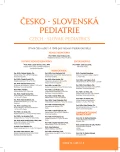Lymph-node syndrome associated with Cat-scratch disease in children treated at the Clinic of Infectious Medicine in Ostrava
Authors:
L. Hozáková 1,2; L. Rožnovský 2; V. Janout 1
Authors‘ workplace:
Ústav epidemiologie a ochrany veřejného zdraví, Lékařská fakulta Ostravské univerzity, Ostrava
1; Klinika infekčního lékařství, FN Ostrava
2
Published in:
Čes-slov Pediat 2017; 72 (5): 301-307.
Category:
Original Papers
Overview
Objectives:
A retrospective evaluation of a group of nineteen patients with cat scratch diseases which is focused on epidemiological context, clinical picture, serological diagnosis and therapy.
Material and methods:
Catch-scratch disease (CSD) was considered in children within the scope of the differential diagnosis of lymphadenopathy. It was being found out injury by cat or at least contact with cat, localization of the lymph-nodes and other clinical signs. Serological diagnosis was based on detection of antibodies against Bartonella henselae by indirect immunofluorescence. It was being found out indication and duration of antibiotic therapy, duration of lymph-node syndrome and antibodies against B. henselae. Findings of granulomatous inflammation in extirpated lymph node supported suspicion of CSD.
Results:
From 2008 to 2016 nineteen children with CSD were examined at the Clinic of Infectious Medicine in Ostrava. The group consisted of twelve boys and seven girls. Fifteen out of nineteen children had contact with cat but only five children reported injury caused by cat. Cervical lymph nodes were affected the most often, in fifteen children, and four children had affected nodes in more sites. Two children had discolored skin above lymph node. Ten children had fever. Extirpation of lymph node was performed in five children, three times with finding of granulomatous and twice with granulomatous-suppurative changes. Positive IgM antibodies were detected only in twelve children. IgG antibodies were in the titres 1:64 – 1:2048. Children were treated with macrolides for 2–3 weeks.
Conclusions:
In the group of nineteen children cervical lymph nodes were affected the most often, four children had lymph nodes in more sites. Positive IgM antibodies were detected in twelve children, lymph nodes extirpation was performed five times. Macrolides were used for treatment of CSD for 2–3 weeks.
KEY WORDS:
cat scratch disease, lymph node syndrome, serology, extirpation
Sources
1. Pennisi MG, Marsilio F, Hartmann K, Lloret A. Bartonella species infection in cats. ABCD guidelines on prevention and management. J Feline Med Surg 2013; 15 (7): 563–569.
2. Slater LN, Welch DF. Bartonella, including cat-scratch disease. In: Mandell, Douglas, Bennett. Principles and Practice of Infectious Diseases. 6th ed. Philadelphia: Elsevier, 2005: 2733–2748.
3. Melter O, Hercík K, Weyant RS. Detection and characterization of feline Bartonella hensellae in the Czech Republic. Vet Microbiol 2003; 93 (3): 261–273.
4. Fleischman DA, Chomel BB, Burgos K. Impact of queen infetion on kitten susceptibility to different strains of Bartonella henselae. Vet Microbiol 2015; 180 (3–4): 268–272.
5. Melewska KM, Mania A, Kemnitz P, et al. Cat-scratch disease: a wide spectrum of clinical pictures. Postepy Dermatol Alergol 2015; 32 (3): 216–220.
6. Melter O. Novinky v problematice bartonelových infekcí. Klin Mikrobiol Inf Lek 2013; 9 (2): 36–44.
7. Maciás A, Aguirre C, Bustamante A, et al. Cat scratch disease in Colombia. Oxf Med Case Reports 2014; 1 (3): 43–45.
8. Lindeboom JA. Pediatric cervicofacial lymphadenitis caused by Bartonella henselae. Oral Surg Oral Med Oral Patho Oral Radiol 2015; 120 (4): 469–473.
9. Shasha D, Gilon D, Vernea F, et al. Visceral cat scratch disease with endocarditis in an immunocompetent adult: a case report and review of the literature. Vector Borne Zoonotic Dis 2014; 14 (3): 175–181.
10. Brunetti E, Fabbi M, Ferraioli G, Prati P. Cat-scratch disease in Northern Italy: atypical clinical manifestations in humans and prevalence of Bartonella infection in cats. Eur J Clin Microbiol Infect Dis 2013; 32 (4): 531–534.
11. King KY, Hicks MJ, Mazziotti MV, Eldin KW. Persistent cat scratch disease requiring surgical excision in a patient with MPGN. Pediatrics 2015; 135 (6): e1514–e1517.
12. Nelson CA, Saha S, Mead PS. Cat-scratch disease in the United States, 2005–2013. Emerg Infect Dis 2016; 22 (10): 1841–1846. doi:10.3201//eid2210.160115.
13. High K, Van Meter J. An 8-year-old boy with altered mental status. Air Med J 2015; 34 (3): 149–151.
14. Zenone T. Systemic Bartonella henselae infection in immunocompetent adult presenting as fever of unknown origin. Case Rep Med 2011; 2011: 183937. doi:10.1155/2011/183937.
15. Sanguinetti-Morelli D, Angelakis E, Richet H. Seasonality of cat-scratch disease, France, 1999–2009. Emerg Infect Dis2011; 17 (4): 705–707. doi:10.3201/eid1704.100825.
16. Hozáková L, Rožnovský L, Franková H. Felinóza – stále aktuální zoonóza. Klin Mikrobiol Inf Lek 2014; 20 (1): 4–10.
17. Meier JD, Grimmer JF. Evaluation and management of neck masses in children. Am Fam Physician 2014; 89 (5): 353–358.
18. Laswell EM, Chambers KD, Whitsl DR, Poudel K. New-onset refractory epilepticus in an adult with an atypical presentation of cat-scratch disease: successful treatment with high-dose corticosteroids. Pharmacotherapy 2015; 35 (6): e106–e110.
19. Kimura A, Hasegawa S, Yanagihara M, Inoue H. Cat-scratch disease with severe pleuritis in a 6-year-old girl. Pediatr Int 2015; 57 (3): 501–503.
20. Mirouse G, Journe A, Casabianca L, Moreau PE. Bartonella henselae osteoarthritis of the upper cervical spine in a 14-year-old boy. Orthop Traumatol Surg Res 2015; 101 (4): 519–522.
21. Gradidge E, Chauhan A, Stelle RW, et al. Fever, lymphadenopathy, and splenomegaly: did the cat do it? Clin Pediatr (Phila) 2013; 52 (11): 1072–1074.
22. Jabcuga CE, Jin L, Macon WR, Howard MT. Broadening the morphologic spectrum of bartonela henselae lymphadenitis. Analysis of 100 molecularly characterized cases. Am J Surg Pathol 2016; 40 (3): 342–347.
Labels
Neonatology Paediatrics General practitioner for children and adolescentsArticle was published in
Czech-Slovak Pediatrics

2017 Issue 5
Most read in this issue
- Histamine intolerance in childhood – case reports from clinical praxis
- Correction of congenital breast and chest wall malformations by lipomodelling technique
- Enteral nutrition in the treatment of inflammatory bowel disease
- Perianal lesions – condylomata or Crohn’s disease?
